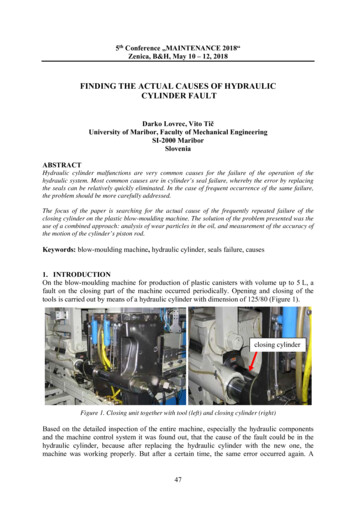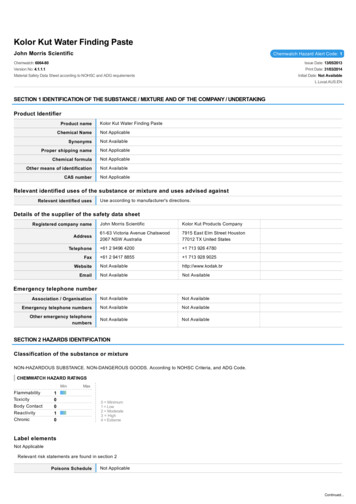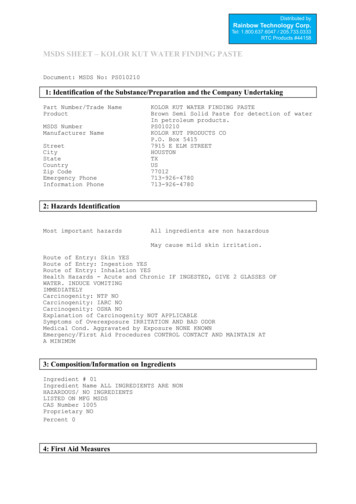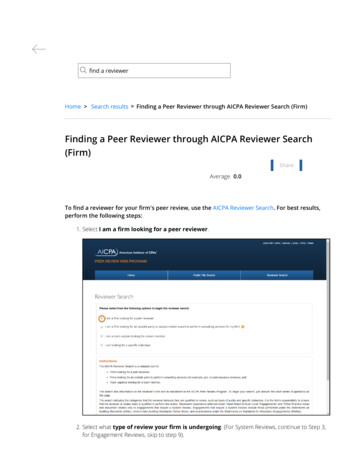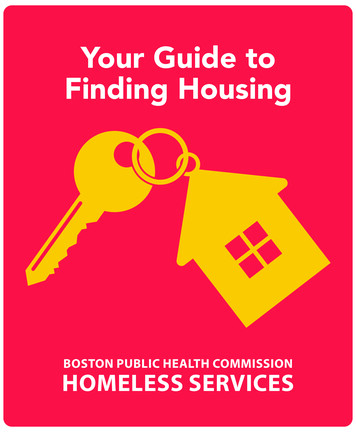
Transcription
Your Guide toFinding HousingBOSTON PUBLIC HEALTH COMMISSIONHOMELESS SERVICES
Hi there,Our goal is that your stay with us is as short as possible.We want you to find a safe place to call home. This can bea difficult and confusing process.We put together this housing guide to help you understandthe key steps to finding housing. We included tips fromformer guests and staff. This is just an overview, and youmight still have questions. Feel free to ask a staff memberfor more information.We believe that finding a safe place to call home should beyour top priority. Staying in shelter a long time can take asignificant toll on your health and wellbeing. We’ve foundthat once you have a safe place to call home, it’s easier to makeprogress on other goals you might have such as increasing yourincome and working on your health and recovery.We encourage you to ask yourself every day, “What am Idoing today to make progress toward housing?”Best,-Staff and guests at BPHC
Make a PlanBefore you get started ask yourself these questions:1.What’s your housing goal?4.What type of housing would work for you right now?(see an overview of options on the next page)5.What might get in your way from achieving your goal?2.What’s your monthly income?6. Any other specific constraints or limitations? (examples: Do you need anelevator or hearing impaired unit? Do you have a service animal?)3.What cities and neighborhoods are you open to living in?Tips: Focus on what type of housing you could make do withright now (it might be different than your long-term goal).Remember that the first place you move after shelter doesnot have to your dream home. It could be a stepping stonetoward your long term goal.23
Know Your Housing OptionsCommon types of housingWhat type of housing would work for you right now?Here is an overview of common housing options that guests use: SRO: A Single Room Occupancy or SRO, where you would share thecommon areas, kitchen and bathroom but enjoy the privacy of yourbedroom. Studio: A small apartment which combines, many times but notalways, the living room, bedroom, and kitchen into a single room. One Bedroom: A basic apartment that has a separate bedroom, akitchen, a living room, and a bathroom. Feel like you might need more support in housing?Some great alternative housing options include: sober homes,nursing homes or rest homes, Department of Mental Health SafeHavens, or living with supportive family or friends. Shared Living: An apartment where you can have roommates ofyour choice or move in with others. Typically, there would be lessindividuals sharing this living space than there would be in an SRO. 4Tip: If you don’t like the thought of livingwith roommates you haven’t met, find anotherguest or two and look for a place together.5
Market-Rate Housing vs. Subsidized housingMost of the housing types listed on pages 4 and 5 are available torent from a private landlord (market-rate unit) or with a subsidy(subsidized housing) However, there are some important things tokeep in mind about these:Market-Rate Housing Enter into a lease with a private landlord You (along with roommates if you have them) pay the full rentthe landlord is asking forSubsidized Housing Vouchers, “Section 8 vouchers,” public housing or otherdevelopments have these units that calculate your rent portionbased on 30-40% of your monthly gross income More discretion in what location you want Stricter screening criteria, which can at times exclude individualswith negative criminal, credit, and/or housing history Fewer screening criteria. Good option if you are concerned aboutany criminal, credit and/or housing history Very little supply - there is only enough for about 1 out of 4people who income qualify Fastest way to get housing Very long wait times – the average wait time is 5 years but couldbe as long as 10 Able to keep applying for subsidized housing while living inmarket-rate housing Often able to get some financial assistance for market-ratehousing, if you complete a Pathways AssessmentTip: Learn how other guests made market-ratehousing work for them on page 12.67
Tips: Make small goals every day of how you’ll advance your housingsearch. Example: Today I will call three landlords and will visit one unit.Starting a private market housing searchExpand your housing search by searching in different neighborhoods.Rent will vary depending on the location.Start looking for housing options that might work for you. Thisprocess can be tiring and at times discouraging, but hang in there.Call landlords during the time of day when you’re at your best,return calls quickly, and keep conversation brief.Where you can look for housing opportunities Daily Newspaper (i.e. Metro, Herald, Globe)8Reach out to landlords and/or management companiesand ask to schedule a home visit/tour. Online (i.e.: Craigslist, Hotpads, Zillow)Ask questions such as: Private Landlords in the community Are utilities included? Visiting/Calling various management companies What are the move-in fees? Word of mouth: Tell people (anyone and everyone) that you’relooking and what you’re looking for. You never know who mighthave a lead. What will the move-in date be? Do you accept vouchers?9
Applying for subsidized housingThings to remember when completing housing applications Complete the entire rental application Never leave a question blank.-Write “N/A” if the question does not apply. Always be as honest as possible when answering questions on anyapplication. Failure to disclose things on your application couldcreate problems when your application is processed. Always provide accurate information on misdemeanors, closed,or dismissed cases even if there was no conviction.Improving negative background information Some landlords and/or management companies may requestto conduct a background check. Request a CORI ahead of time from a BPHC case managermember so that you know what a future landlord might see. Close open cases Seek out CORI sealing clinics Gather letters of reference from as many peopleas possible that give specific examplesThe importance of checking and responding to mail Subsidized housing providers typically onlycommunicate in writing and by mail. You can loseout on a housing offer if you don’t respond to mail. Establish a stable mailing address (friend, family, PO Box, etc)that you check frequently If your address changes, make sure to update your mailingaddress IN WRITING to everywhere you applied.Unit Inspections For most subsidized housing options, such as using a voucher, yourunit will need to pass inspection before you can move in. This can add time to your ideal move in date. It is not uncommonfor a unit to not pass inspection on the first try.1011
How do people afford a market-rate unit?If you feel overwhelmed by taking a unit in the private market,here are tips that guests compiled on how they made it work: Balancing the Budget and Using the Income Services: some findways to pay less for things like utilities and groceries, and earn extraincome through part-time work, informal work, or increasing benefits.Others find a program that has an income maximization specialist tohelp them find work and/or balance the budget. Negotiating rent down: some people build a good relationshipwith their landlord by paying rent on time and ensuring there are nolease violations; after a relationship is built, they can sometimes negotiate the rent down. Roommates: some people find a roommate to share the rent, orsome people find a roommate after they have moved in to bring thecost down. Moving out of the immediate Boston area: some peoplesettle into less costly areas that are still connected to transportation (including the commuter rail and bus lines) to keep rentalcosts down. Continue to apply for subsidized housing: most subsidizedhousing programs do not have a homeless requirement, only afew do. Once housed, some people make sure they apply to asmany subsidized units as they can, and respond to all mailings andaddress updates so they can move to the top of the list. Move in with family or friends: some people move into a unitbut struggle to maintain the rent, so they relocate with friends andfamily to avoid homelessness again. Single Rooms: Many rent a single room occupancy (SRO), which isless expensive.1213
Get your documentsImportant note: If you’re planning to apply for subsidized housing,you should start working on that to get your name on multiplewaitlists and then work on getting your documents while you wait.See page 9 for applying to subsidized housing.These are the most common documents you’ll need when applyingfor housing: (Depending on the type of housing you might not need all ofBank Statementsthese or you might need a few other things like an Income Verification)Birth CertificateSocial Security CardHomeless Verificationand/or letter with yourhomeless bed staysTip: Make color copiesof your ID and find asafe and dry place tostore them (make sureyou or a staff signs thecolor copy).You can ask a casemanager to uploadthem to Windows tothe Warehouse. Thiscreates a safe backup of them in casethey get lost or stolen.Valid Government Issued-ID14Proof of ResidencyProof of Income (paystub,benefit letter etc.)15
Sign your leaseRead the full lease! Make sure you agree with the leaseand the lease addendum if applicable.Make sure: To confirm the length of lease: some leases are 1 year-long whileothers may be “month-to-month” or a “tenant at will” The lease specifies any required fees in addition to monthly rent:Common fees include first and last month’s rent, security deposit,and lock out fees etc.Move-in fees will be expected when you sign your lease.Make sure to: Plan for how you will pay for these or find assistance to pay for them Request receipts for all payments made Once a lease is signed and payments have been made, youshould receive the keys to your new HOME! You request a copy of the signed lease: it should be signed byyou and the property owner.Notes: If you are currently experiencing homelessness,you may qualify for financial assistance with payingfirst, last, and security deposit.1617
Schedule move in and order furnitureHOUSING CHECKLIST: Keep track of your progressMoving in can be both exciting and stressful.Here are some things to keep in mind:m Vital Documents Obtained Moving van: If you have items in storagework to arrange a moving van. Furniture. Ask a staff member about Furniture Resources/Referrals. Common places people look for furniture include:- Furniture banks- BOB’s- Boston Basics- Amazonm Contacted Landlord and/or Property Ownerm Scheduled Viewingm Application Completedm CORI Requested (if needed)m Unit Inspected (if needed)m Reviewed and Signed Lease Get to know your neighborhood: Prepare for your move byvisiting your new neighborhood beforehand to learn wherethings are (grocery store, the bank, health center, etc)Notes: Make a list of what items are most essential to youwhen you first move in.18At times there are resources to help with both orderingfurniture and scheduling movers.Resources for furniture will vary. If you have a case manager,ask them about what resources you might qualify for.m Move-In Fees Confirmedm Requested Furniture Assistance from Case Managerm Furniture Delivery scheduled for :m Planned move in date and move in logistics19
Units I’ve contacted or am looking at:Address:Landlord Name/Phone Number:Price:Notes/Details:Address:Landlord Name/Phone Number:Price:Notes/Details:Address:Landlord Name/Phone Number:Price:Notes/Details:Address:Landlord Name/Phone Number:Price:Notes/Details:20Notes/Questions:21
Very long wait times – the average wait time is 5 years but could be as long as 10. 8 9 Start looking for housing options that might work for you. This process can be tiring and at times discouraging, but hang in there. Where you can look for housing opportunities Daily Newspaper (i.e. Metro, Herald, Globe) Online (i.e.: Craigslist, Hotpads, Zillow) Private Landlords in the .



